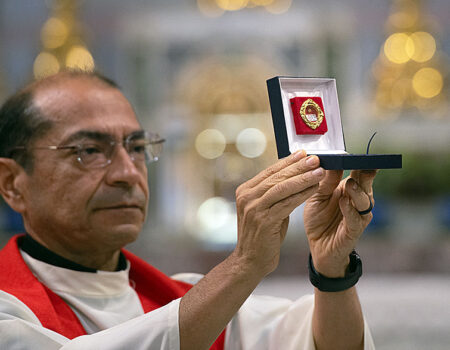Reintroducing the Heart of Jesus
Friday June 27, 2025

On 24 October 2024, the Holy Father, Pope Francis, published his fourth Encyclical, entitled Dilexit Nos. Pope Francis aims to make known the Heart of Christ, given that many distortions have spread. The focus of the text is to reaffirm that God loved us with a human heart. We believe that this centrality of the human heart of Jesus is deeply connected to the spirituality of the Heart in Dilexit Nos and that proposed by Fr. Júlio Chevalier, who also urged us to realise how God loved us with a human heart.
The Encyclical seeks to refocus the heart on spirituality, not from a superficial perspective, but as the vital centre of existence and human relationships (DN, n. 1-3), considering the power of love that is reported in the quotations that the Encyclical brings in its first number (cf. Rom 8:37; Rom 8:38; Jn 15:9, 12; Jn 15:15; 1 Jn 4:10; 1 Jn 4:16), by showing how God loved us, not formally or ceremonially, nor in a commercial dynamic, but out of pure gratuitousness (His open heart precedes us and waits for us unconditionally, without demanding any prerequisite for loving us and offering us his friendship, DN, n. 1). Dilexit Nos strives throughout the text to make this gratuitousness clear, for it seems that it is by restoring this precious gratuitousness that we can arrive at a spirituality of the Heart that is neither superficial nor commercial.
In the section on returning to the Heart (DN, n. 9-16), drawing on the Polish philosopher Bauman’s concept of the ‘liquid world,’ Pope Francis expresses concern about a heartless world where relationships are volatile, affections are fluid and unanchored, and the world claims to be rational but is in fact satisfied by deviations from virtue. This risk is amplified in the world of algorithms, which seem to mirror all relationships. Through what algorithms show us, we may assume that our worldview is the only one possible, which is a paradox of the liquid world. The Pope tells us, ‘The algorithm that operates in the digital world shows that our thoughts and decisions are much more ‘standard’ than we thought. They are easily predictable and manipulable. This is not the case with the heart’ (DN, n. 14). To restore the centrality of the Heart is to correct such erroneous tendencies present in contemporary society.
_
The Pope tells us, ‘The algorithm that operates in the digital world shows that our thoughts and decisions are much more ‘standard’ than we thought. They are easily predictable and manipulable. This is not the case with the heart’ (DN, n. 14).
In a fragmented society, the heart is the place to restore unity (DN, n. 21), which is why the Heart of Jesus is the image of the union of the Heart of God with the human heart. It is capable of unifying history and people. It is in this perspective that Francis takes up the teaching on the Heart of Jesus (DN, n. 24-27), through St. Ignatius, St. Bonaventure, and other Church figures. Returning to Sacred Scripture, the feelings of the Heart of Christ are present in his gaze, in his words and his gestures (DN, n. 32-47).
Not separating the heart from the person is an effort of the Encyclical.
Devotion to the Heart of Christ is not the worship of an organ separate from the Person of Jesus. What we contemplate and adore is Jesus Christ in his entirety, the Son of God made man, represented in an image of himself in which his heart is highlighted. In this case, the heart of flesh is understood as an image or privileged sign of the most intimate centre of the incarnate Son and of his love, which is at once divine and human, because, more than any other member of his body, it is ‘the natural index or symbol of his immense charity’ (DN, n. 48)
The Heart of Jesus is not just an organ, but the centre of his person.
When we worship the Heart of Jesus, we worship the person of Jesus. On this theme, as on others that we could list, Pope Francis and Jules Chevalier converge, for the heart is the whole person of Jesus, as it is for us. Still, in Jesus, the Son of the living God, it reflects the unity between Jesus and the Father and the unity between Jesus and the human race. From this theology emerges a spirituality centred on the unification of the person with God and with humanity, to the point that a missionary congregation of such spirituality is born. Cuskelly tells us about Chevalier’s spirituality:
Júlio Chevalier had learned to turn his gaze constantly to Jesus ‘who brings our faith to completion’. He had learned to admire Christ as the ‘splendour of God’s glory and the perfect expression of his nature’. But it was only then that he learned that the nature of God is love. It was only then, through his devotion to the Sacred Heart, that he learned that ‘this only Son, begotten from all eternity by the Heart of God the Father, is the radiance of his charity among men’ (Cuskelly, p. 115)
If Pope Francis aimed to reintroduce the Heart of Jesus and devotion to it in our time, the same can be said for Fr. Jules Chevalier, who regarded the Heart of Christ as the remedy for humanity’s ills. Chevalier believed that the evils of humanity could be resolved through the discovery of the Heart of Jesus (Cuskelly, p. 113), as the Heart, filled with love and mercy, restores life and grace to people. The Encyclical Dilexit nos provides us with some insights that it also seeks to address evils, including what we might term neo-Jansenism and disembodied spiritualities, akin to neo-Gnosticism.
It could be said that today, more than Jansenism, we are facing a strong advance of secularisation that aims at a world free of God. Added to this is the proliferation in society of various forms of religiosity without reference to a personal relationship with a God of love, which are new manifestations of a ‘spirituality without flesh’. This is real. However, I must warn that, within the Church itself, the harmful Jansenist dualism has been reborn with new faces. It has gained renewed strength in recent decades, but it is a manifestation of that Gnosticism which, in the early centuries of the Christian faith, damaged spirituality and ignored the truth of the ‘salvation of the flesh’. For this reason, I turn my gaze to the Heart of Christ and invite you to renew this devotion. I hope that it will also appeal to today’s sensibilities and thus help us to face these old and new dualisms, to which it offers an adequate response. (DN, n. 87)
God loved us with a human heart; this represents the convergence between Dilexit nos and Chevalier. From this affirmation arises our mission to make the Sacred Heart loved. From this assertion, we can see a remedy for the evils of humanity. Hence, there is an urgency in repositioning the heart and re-presenting the Heart of Christ as the unifying centre between men and humanity with God. This is our mission: to make the Sacred Heart of Jesus loved everywhere.
Abimael Francisco do Nascimento, MSC (Brasil)
Photo: www.freepik.com





